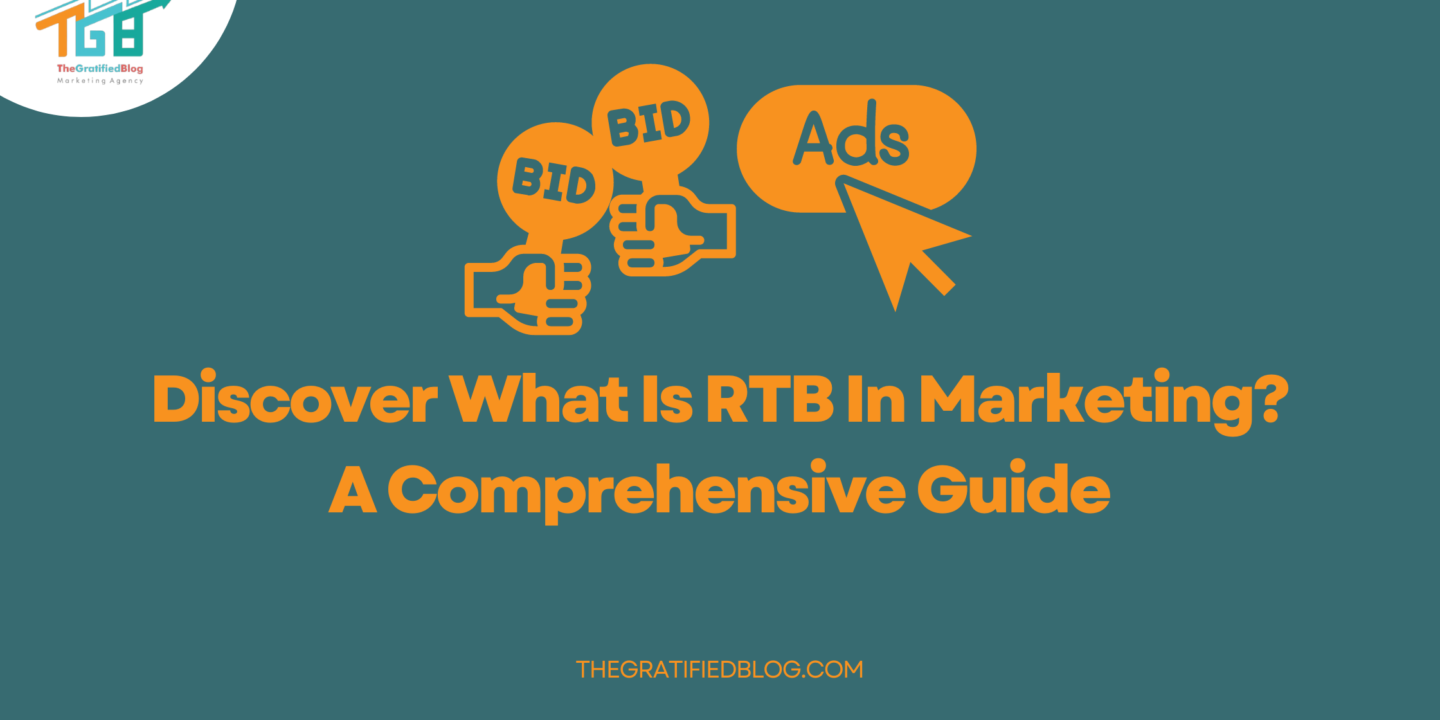
Staying at the forefront is imperative for success in the ever-evolving digital marketing landscape, especially for businesses seeking to optimize online visibility and reach the right audience. Amidst the plethora of acronyms and jargon, RTB, or Real-Time Bidding, frequently surfaces in online advertising discussions. If you wonder, “What is RTB in marketing?” you’re not alone.
In this blog post, we’ll unravel the mystery behind RTB, exploring its significance and functionality and how it plays a pivotal role in reshaping how brands connect with their target consumers in the dynamic world of digital advertising.
So, let’s get started:
What Is RTB In Marketing?
Real-time bidding (RTB) in marketing is a dynamic and sophisticated process that revolutionizes how online advertising inventory is bought and sold.
At its core, RTB is an auction-based system where digital ad space is sold in real time, allowing advertisers to bid on individual ad impressions. Unlike traditional advertising methods involving fixed pricing, RTB enables advertisers to compete for each impression on a per-user basis, ensuring that they only pay for the most relevant and valuable opportunities.
Benefits Of RTB In Marketing
The benefits of RTB in marketing are multifaceted, contributing to the success of digital advertising campaigns. Here are six key advantages:
- Precision Targeting: RTB enables advertisers to target specific audiences with precision. Advertisers can leverage data insights and audience segmentation, Ensuring that their ads are presented to the most pertinent audience and receptive users. Employing this focused strategy enhances the chances of audience engagement and boosts conversion rates.
- Cost Efficiency: With RTB, advertisers bid for ad impressions in real-time auctions. This auction-based model ensures advertisers pay a fair market price for ad space, promoting cost efficiency. Advertisers can optimize their budgets by focusing on high-performing impressions and audiences.
- Real-Time Optimization: RTB allows advertisers to make real-time campaign adjustments based on performance metrics. This flexibility enables quick optimization of ad creatives, targeting parameters, and bidding strategies, ensuring that campaigns stay relevant and practical.
- Increased Transparency: RTB provides transparency into the ad buying process. Advertisers have visibility into where their ads are displayed, the audiences they reach, and the performance of their campaigns. This transparency fosters accountability and empowers advertisers to make informed decisions.
- Access to Diverse Inventory: RTB opens the door to a vast and diverse inventory of digital ad spaces across various websites and platforms. This diversity allows advertisers to explore different channels and formats, reaching their target audience across various online environments.
- Dynamic Budget Allocation: Advertisers can allocate their budgets dynamically across different segments and audiences based on real-time performance. This adaptability ensures that resources are directed toward the most effective channels, optimizing the overall impact of the marketing campaign.
How Does RTB Work?

Real-time bidding (RTB) is a complex but highly efficient process that allows advertisers to bid on and purchase ad impressions in real-time. Here’s a step-by-step explanation of how RTB works:
- User Visits a Website or App: Commencing when a user accesses a website or application with available advertising space. Ad slots typically denote this advertising space, and each slot represents an opportunity to display an ad.
- Bid Request is Sent: When a user lands on a webpage or app, the publisher (the owner of the digital property) recognizes available ad space and sends a bid request to multiple ad exchanges. An ad exchange is a platform that streamlines the purchase and sale of ad inventory.
- Ad Exchange Auction: The ad exchange receives the bid request and conducts an auction among advertisers interested in displaying an ad to the user. Advertisers submit their bids in real-time, indicating the maximum amount they are willing to pay for the ad impression.
- Data Enrichment and Targeting: Advertisers use data and algorithms to decide on bidding. They may consider user demographics, browsing history, and behavioral patterns to ensure their bid targets the most relevant audience.
- Winning Bid Determination: The auction concludes, and The ad exchange establishes the winning bid by considering the highest amount offered. The winning advertiser’s ad is then selected to be displayed in the ad space on the publisher’s website or app.
- Ad Display: In real-time, the winning advertiser’s ad is delivered to the user’s device and displayed in the designated ad slot on the website or app. This entire process happens almost instantly, from the user’s initial visit to the ad being displayed.
- User Interaction and Tracking: User interactions are tracked once the ad is displayed. Advertisers monitor metrics such as click impressions; analyzing clicks, impressions, and conversions serves as crucial data for assessing the efficacy of their campaigns and is essential for optimizing future bidding strategies.
- Dynamic Campaign Optimization: Advertisers can adjust their campaigns in real-time based on performance data. This may involve tweaking bidding strategies, refining ad creatives, or modifying targeting parameters to ensure the best possible outcomes.
By operating in real-time and leveraging data-driven insights, RTB streamlines the ad buying process, allowing advertisers to connect more efficiently with their intended audience and empowering publishers to optimize the worth of their ad inventory. The entire cycle, from bid request to ad display, takes only milliseconds, making RTB a swift and efficient mechanism in digital advertising.
Implementing RTB In Your Marketing Strategy
Implementing Real-Time Bidding (RTB) in your marketing strategy involves a comprehensive approach integrating technology, data, and strategic decision-making. Here’s a detailed guide on how to effectively implement RTB in your marketing strategy:
- Understand Your Goals: Clearly define your marketing objectives and goals. Whether it’s increasing brand awareness, driving website traffic, or boosting conversions, a well-defined goal will guide your RTB strategy and help measure its success.
- Data Collection and Management: Gather and organize relevant data about your target audience. This includes demographic information, browsing behavior, and other relevant data points. A robust data management strategy ensures you have the insights needed for effective targeting in RTB campaigns.
- Select a Demand-Side Platform (DSP): Choose a DSP that aligns with your advertising goals. A DSP technology platform allows advertisers to bid on and manage their ad inventory across multiple ad exchanges. It provides the tools needed to execute RTB campaigns efficiently.
- Integration with Data Management Platform (DMP): Integrate your Integrate Data Management Platform (DMP) with your DSP for enhanced synergy and data management capabilities. Enhance audience targeting. DMPs aggregate and analyze data, enabling advertisers to create more granular audience segments and target users with higher precision.
- Define Targeting Parameters: Utilize the data to set specific targeting parameters. These may include demographics, location, device type, browsing history, etc. The more precise your targeting, the more effectively you can reach your desired audience.
Challenges And Considerations Of RTB
While Real-Time Bidding (RTB) offers numerous benefits in digital advertising, it also comes with its challenges and considerations. Comprehending and tackling these challenges is imperative for marketers and advertisers to implement RTB effectively. Here are some key challenges and considerations:
- Ad Fraud: Ad fraud remains a significant concern in the digital advertising ecosystem. With the rapid pace of RTB transactions, there is an increased risk of fraudulent activities, such as non-human traffic and spoofed domains. Implementing robust measures for detecting and preventing fraud is essential in this context to maintain campaign integrity.
- Brand Safety: Ensuring that ads appear in brand-safe environments is crucial for maintaining a positive brand image. RTB transactions can lead to ads being displayed on websites or content that may be inappropriate or detrimental to a brand. Employing brand safety tools and thorough vetting of ad placements is necessary to mitigate this risk.
- Data Privacy and Compliance: As RTB relies heavily on user data for targeted advertising, there are growing concerns regarding data privacy and Conforming to regulations such as GDPR and CCPA (California Consumer Privacy Act). Advertisers must prioritize user consent, adhere to data protection laws, and implement measures to secure user data.
- Transparency Issues: Lack of transparency in the RTB process can challenge advertisers. The complexity of the ad tech ecosystem sometimes makes it difficult for advertisers to fully understand where their ads are being displayed and how their budgets are being allocated. Advertisers should work with transparent partners and demand clarity in reporting.
- Ad Viewability: Ensuring that ads are served and viewed by real users is a concern in RTB. Ad viewability issues, such as ads appearing below the fold or being served in non-viewable areas, can impact the effectiveness of campaigns. Monitoring and optimizing for ad viewability is crucial to achieving desired outcomes.
FAQs
Q1. What Exactly Is Real-Time Bidding (RTB) In Marketing?
A. Real-time bidding is a programmatic advertising method where ad impressions are bought and sold in real-time auctions. Advertisers bid on each impression individually, allowing for precise targeting and efficient use of advertising budgets.
Q2. How Does RTB Differ From Traditional Advertising Methods?
A. RTB differs from traditional methods by enabling advertisers to bid on ad impressions in real-time auctions. This dynamic approach allows for more targeted and data-driven ad placements, ensuring messages reach specific audiences with greater precision.
Q3. What Role Does Data Play In RTB Campaigns?
A. Data is fundamental to RTB, allowing advertisers to make informed bidding decisions. Advertisers leverage user data to target specific audiences based on demographics, behavior, and other factors, optimizing the relevance and effectiveness of their campaigns.
Conclusion
Real-time bidding (RTB) has revolutionized the way marketing campaigns are executed. Despite the challenges and considerations associated with RTB, its benefits far outweigh the drawbacks. By taking the necessary precautions to minimize ad fraud, investing in reliable data sources, continuously monitoring and optimizing campaigns, and ensuring compliance with privacy regulations, businesses can successfully implement RTB and achieve remarkable results.
Looking to the future, RTB is expected to continue its growth and dominance in the advertising industry. As a result of technological progress and shifts in consumer behavior, the need for targeted and personalized advertising will only intensify. RTB provides the perfect solution by enabling brands to reach their desired audience in real time, making it an invaluable tool for marketers worldwide.
The following section will explore the best practices for implementing RTB in your marketing strategy. We will explore tips and insights to maximize ROI and overcome any challenges you may face. Stay tuned for valuable advice to help you make the most of your RTB campaigns.








No Comments